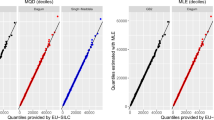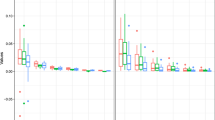Abstract
Since M. Zenga introduced in 1984 his point concentration measure Z p , based on the ratio between population and income fractiles, and the synthetic measure ζ, which is the espected value of Z p (Zenga, 1984), several authors have been interested in the analyses of the characteristics and properties of these measures. Particular attention has been devoted to the Z p concentration curve, which can be obtained by representing in the unit square the points (p, Z p ), p ϵ [0, 1]. The behaviour of the Z p curve has been studied both for theoretical models — rectangular, exponential, Pareto type I and lognormal (Zenga, 1984), generalized lognormal (Pollastri, 1987), Dagum type I (Dancelli, 1989) - and empirical distributions (Salvaterra, 1985, 1987). In the theoretical studies the Z p curve has shown a wide variety of behaviours. In particular the three-parameter models considered by Pollastri and Dancelli can take the form of a curve convex to the p-axis, when the non-scale parameters take values in given ranges. Such a curve seems to be able to represent the point concentration that is peculiar to many empirical distributions. Indeed empirical studies very often have shown that the point concentration curve Z p is a decreasing function of p for low income groups and an increasing one for high income groups. However observed income distributions have shown cases of increasing values of Z p in correspondence to low incomes. Their characteristics have suggested that such behaviour of Z p can derive from the existence of a lower positive income bound. The remark has given rise to this study the main purposes of which are: (1) to investigate the causes of the behaviour of theZ p curve; (2) to analyse the consequences on the Z p curve of a single or double truncation of the distribution.
Access this chapter
Tax calculation will be finalised at checkout
Purchases are for personal use only
Preview
Unable to display preview. Download preview PDF.
Similar content being viewed by others
References
Dagum, C. (1971). Un modèle stocastique de répartition fonctionnelle du revenu. Economie et Sociétés, séries économie, mathématique et econométrie, v. 5, n. 10, pp. 1729–1751.
Dagum, C. (1973). Un modèle non linéaire de répartition fonctionnelle du revenu. Economie Appliquée, v. 26, n. 1, p p. 843–876.
Dagum, C. (1975). A Model of Income Distribution and the Conditions of Existence of Moments of Finite Orders. Bulletin of th e International Statistical Institute, Proceedings of the 40th session, v. 46, n. 3, pp. 196–202.
Dagum, C. (1977). A New Model of Personal Income Distribution: Specification and Estimation. Economie Appliquée, v. 30, n. 3, pp. 413–437.
Dagum, C. (1980). The Generation and Distribution of Income, the Lorenz Curve and the Gini Ratio. Economie Appliquee, v. 33, n. 2, pp. 327–367.
Dagum, C. (1983). Income Distribution Models, Encyclopedia of Statistical Sciences, v. IV, Johnson and Kots Eds, Wiley & Sons, pp. 27–34.
Dagum, C. (1987). Measuring the Economic Affluence Between Populations of Income Receivers. Journal of Business & Economic Statistics, v. 5, n. 1, pp. 5–12.
Fortunati, P. (1955). Schema di graduazione, misure di variabilità e valori medi. Statistica, XV, 1, pp. 251–278.
Nygård, F. & Sandström A. (1981). Measuring Income Inequality. Almqvist & Wiksell International, Stockholm.
Ord, J.K. & Patil, G.P. & Taillie, C. (1983). Truncated Distributions and Measures of Income Inequality. Sankhyā, series B, 45, pp. 413–430.
Piesch, W. (1975). Statistische Konzentrationsmaβe. J.C.B. Mohr, Paul Siebeck, Tubingen. Pietra, G. (1915). Delle relazioni tra indici di variabilità, note I e II. Atti del Reale Istituto Veneto di Scienze, Lett ere ed Arti, a.a. 1914–15, LXXIV, pp. 775–804.
Pollastri, A. (1987). La curva di concentrazione di Lorenz e di Zenga nella distribuzione log-normale generaiizzata. Giornale degli Economisti e Annali di Economia, 11–12, pp. 639–664.
Salvaterra, T. (1985). Problemi di caicolo della curva di concentrazione di Zenga e dell’indice di concentrazione, Pubblicazioni dell’Istituto di Statistica e Ricerca Operativa dell’Università di Trento, serie provvisoria.
Salvaterra, T. (1987). Analisi comparata dei procedimenti di calcolo dei rapporti di concentrazione Z(p) e dell’indice di concentrazione di Zenga. In “La distribuzione personale del reddito: problemi di formazione, di ripartizione e di misurazionea”cura di M. Zenga, Vita e Pensiero, Milano, pp. 230–249.
Taguchi, T. (1968). Concentration-Curve Methods and Structures of Skew Populations. Annals of the Institute of Statistical Mathematics, 20, pp. 107 - 141.
Zenga, M. (1984). Proposta per un indice di concentrazione basato sui rapporti tra quantili di popolazione e quantili di reddito. Giornale degli Economisti e Annali di Economia, XLIII, 5–6, pp. 301–326.
Author information
Authors and Affiliations
Editor information
Editors and Affiliations
Rights and permissions
Copyright information
© 1990 Springer-Verlag Berlin Heidelberg
About this paper
Cite this paper
Dancelli, L. (1990). On The Behaviour of the Z p Concentration Curve. In: Dagum, C., Zenga, M. (eds) Income and Wealth Distribution, Inequality and Poverty. Studies in Contemporary Economics. Springer, Berlin, Heidelberg. https://doi.org/10.1007/978-3-642-84250-4_8
Download citation
DOI: https://doi.org/10.1007/978-3-642-84250-4_8
Publisher Name: Springer, Berlin, Heidelberg
Print ISBN: 978-3-540-52863-0
Online ISBN: 978-3-642-84250-4
eBook Packages: Springer Book Archive




